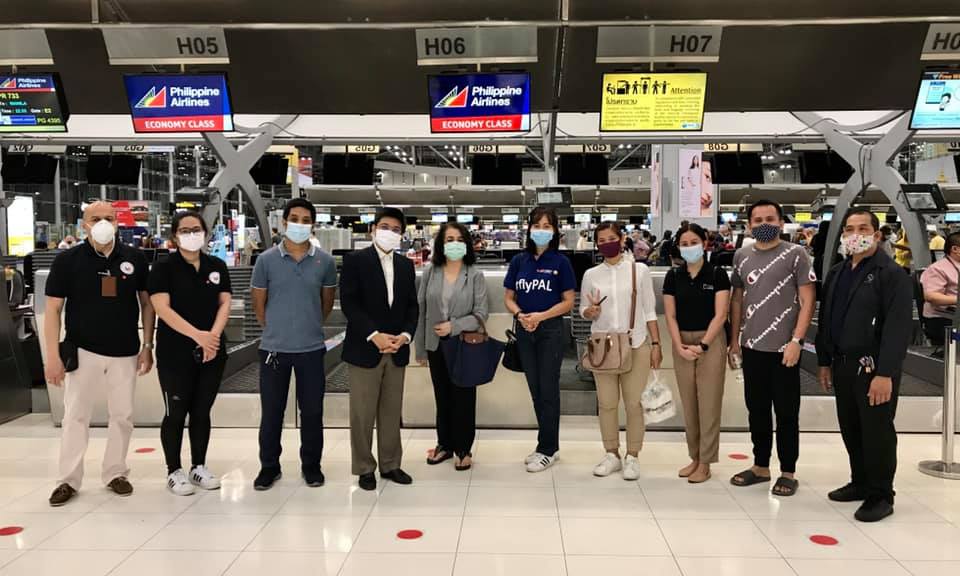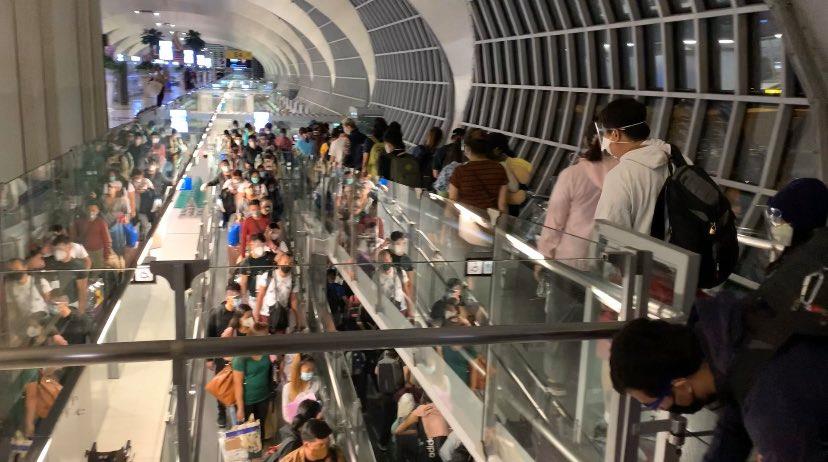Riu Rodriguez, a UP student, finally heaved a sigh of relief. He was among the 228 Filipinos who are either OFWs who lost their jobs or stranded tourists who were not able to return home when the airports halted commercial flights in late March. They were aboard flight PR733 of Philippine Airlines (PAL) departing Bangkok to Manila at 11:30 on the evening of July 5.
The repatriates arrived at Ninoy Aquino International Airport (NAIA) Terminal 2 at 4 am on Monday, July 6.
Rodriguez was under the exchange student program of MOVE UP (Mobility for Vigor and Excellence University of the Philippines) to Chulalongkorn University starting January 2020. The semester ended on May 7. However, due to COVID-19, he remained in Bangkok until July when a second chartered flight was approved by the Civil Aviation Authority of Thailand (CAAT).
Meanwhile, the same special flight from Manila, Philippines, PAL Flight PR732 brought home 274 Thais stranded in the Philippines.
Chartered flights
The Philippine Embassy repatriated a total of 962 Filipinos, including workers who lost their jobs and tourists on April 24, May 14, and June 29. Another 184 Filipinos were repatriated on June 25, via PH AirAsia chartered flight organized by Bangkok Vista Holidays Company in coordination with Filipino Community Leaders and the Philippine Embassy.
Upon its success, Ms. Zenaida Vannaying, CEO of Bangkok Vista Holiday Co. Ltd, the Philippine Embassy and the FILCOM, also arranged the second chartered flight with PAL Thailand Office.
Consul General Val Roque and staff of the Philippine Embassy assisted the repatriates. Ms. Vannaying, also a restaurateur, provided free food.
On their website, PAL announced that it would resume its international flights to various destinations, including Bangkok, but subject to change due to the situation.
“We advise passengers to check the PAL website for the announcements,” Aileen Santos, PAL Country Manager in Thailand, said.

(fourth from left) ConGen Val Roque, Ms. Zenaida Vannaying, CEO of Bangkok Vista Holiday, Ms. Aileen Santos of PAL, FILCOM leaders and embassy staff (Photo by PinoyThaiyo)
Home
After undergoing the necessary process of briefing, testing, immigration, and DOT (Department of Tourism hotel bookings, the Filipino repatriates will undergo a mandatory quarantine despite zero-local transmission in Thailand for 41 days.
COVID-19 testing for non-OFW costs Php 3,500. The result of the COVID-19 RT-PCR (Reverse Transcription Polymerase Chain Reaction) test will be released after 3-5 days. If the test result is negative, they can go home and will undergo another 14-day self-quarantine. Those who turned out positive will be turned over to the Department of Health (DOH) for evaluation.
Rodriguez shared that members of the Philippine Coastguard were at the airport to maintain “order” in the queue. The Coastguard team also gave them orientation on the quarantine process.
Rodriguez currently stays at Balay International, a quarantine facility arranged by UP Diliman Office of International Linkage while waiting for the COVID-19 test result.
“DOT-accredited hotels for non-OFWs are expensive. At Balay International, I pay Php 940, excluding meals. Meals are placed in front of our doors at 8 a.m, 12 noon, and 6 pm. It is prohibited to walk outside of my room,” Rodriguez shared.
Visa Amnesty for stranded foreigners
On March 21, Thailand borders closed. It was followed by suspension of commercial flights starting March 26. Tourists and other visa holders are given amnesty until July 31.
As part of its Phase-5 easing measures, Thailand has reopened 37 checkpoints on the borders with Myanmar, Laos, Cambodia, and Malaysia. However, only cargoes and traders are allowed to cross the borders.
Tourism will kickstart as soon as the ‘travel bubble’ scheme pulls through. The scheme allows limited international travel to Thailand from countries with a ‘reciprocal agreement’. So far, it includes Taiwan, Japan, and some provinces in China with zero recorded COVID-19 for at least 60 days. Only 1,000 tourists are allowed to enter Thailand each day.
According to the Tourism Authority of Thailand, these are the following persons allowed to enter Thailand:• Thai nationals.
• Persons with an exemption or persons being considered, permitted or invited by the Prime Minister, or the head of responsible persons accountable for resolving the state of emergency issues to enter the Kingdom, as necessary. Such consideration, permission or invitation may be subject to specified conditions and time limits.
• Non-Thai nationals who are a spouse, parents, or children of a Thai national.
• Non-Thai nationals who hold a valid certificate of residence, or permission to take up residence in the Kingdom.
• Non-Thai nationals who hold a valid work permit or are allowed to work in the Kingdom, including their spouse or children.
• Carriers of necessary goods subject to immediate return after completion.
• Crew members who are required to travel into the Kingdom on a mission, and have a specified date and time for return.
• Non-Thai nationals who are students of educational institutions approved by Thai authorities, including the parents or guardians of the students.
• Non-Thai nationals who are in need of medical treatment in Thailand, and their attendants. However, this shall not include medical treatment for COVID–19.
• Individuals in diplomatic missions, consular affairs, international organizations, government representatives, foreign government agencies working in Thailand, or individuals in other international agencies as permitted by the Ministry of Foreign Affairs, including their spouse, parents, or children.
• Non-Thai nationals who are permitted to enter the Kingdom under a special arrangement with a foreign country.
Filipinos in Thailand
Despite being stranded in Bangkok, Rodriguez did not really regret it.
“I will definitely visit again! Thailand made me feel at home for six months and I couldn’t be more grateful for the people I’ve met and the memories we’ve shared.”
In a 2017 report by the Department of Employment of Thailand, 14,830 Filipinos currently work in Thailand taking jobs in teaching, management, engineering, architecture, hospitality, and business. It is estimated that there are 17,921 Filipinos in Thailand, according to the Philippine Embassy.
Many Filipinos are also married to Thai nationals.
The number of Filipinos who have lost their jobs is unknown. [ac]


